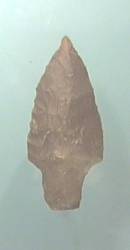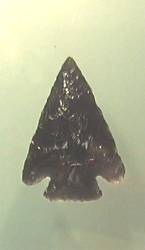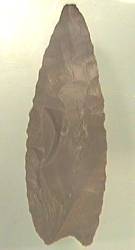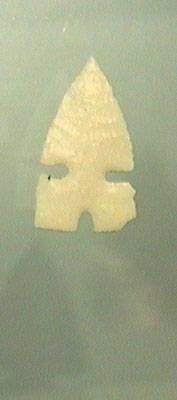Squared: The separation between blade and stem is an abrupt shoulder that forms a roughly perpendicular angle from the proximal boundary of the blade down to the distal margin of the stem. Squared shoulders tend to be made by removal of the corner of the lateral and basal margins of a triangular form.
Barbed: The separation between blade and stem is an abrupt inward curving angle that extends the proximal margin of the blade down past and roughly parallel to the lateral margin of the stem. Barbs tend to be made from long narrow notches introduced from the basal margin.
STEM
EDGE ORIENTATION
This dimension
describes the lateral margin of the stem as diverging or converging angles.
Straight: The lateral margins of the stem are roughly perpendicular to the long axis of the projectile point.
| Contracting: The lateral margins of the stem converge inward toward the proximal end of the long axis of the projectile point. |  |
Expanding: The lateral margins of the stem expand outward toward a basal line drawn at the proximal end of the long axis of the projectile point.
SIZE:
This dimension
describes the relative size the projectile point with relation to neck width.
Large: The projectile point has a neck width of over 1 cm.
Small: The projectile point has a neck width of 1 cm or less.
Indeterminate: Measurement of the neck width of the projectile point cannot be made.
Not applicable: The project point does not have a separable neck or stem.
BASAL
EDGE SHAPE:
This dimension describes
the shape of the basal or proximal margin of the projectile point stem as a
curve.
| Straight: The basal edge of the projectile point tends toward a straight margin with few if any irregularities. |  |
|
Convex: The basal edge of the projectile point bends outward beyond a perpendicular line drawn out from the long axis of the point at the proximal end. |
|
| Concave: The basal edge of the projectile point bends inward from a perpendicular line drawn out from the long axis of the point at the proximal end. |  |
| Point: The basal edge of the projectile point converges sharply at the proximal end of the long axis of the point. |  |
| Straight or concave and notched: The basal edge of the projectile point tends toward a straight margin with few if any irregularities or bends inward from a perpendicular line drawn out from the long axis of the point at the proximal end. The notch extends inward from the basal margin of the stem, but must be seen as wholly confined within the basal margin regardless of presence or absence of curvature. |  |
BLADE
EDGE SHAPE:
This dimension
describes the two-dimensional shape of the blade by characterizing the curvature
of the lateral blade margins.
Straight: The lateral margins of the blade of the projectile point form an essentially straight line with few irregularities.
Excurvate: The lateral margins of the blade of the projectile point bend outward from a straight line drawn between the point at the distal end of the blade and the point at the proximal end of the blade shoulder.
Incurvate: The lateral margins of the blade of the projectile point bend inward from a straight line drawn between the point at the distal end of the blade and the point at the proximal end of the blade shoulder.
Reworked and straight: The lateral margins have been reworked due to breakage of the original projectile point blade. The present blade margin is straight.
Reworked and excurvate: The lateral margins have been reworked due to breakage of the original projectile point blade. The present blade margin is excurvate.
Reworked and incurvate: The lateral margins have been reworked due to breakage of the original projectile point blade. The present blade margin is incurvate.
Indeterminate: Assessment of the blade edge shape of the projectile point cannot be made. Not applicable.
CROSS
SECTION:
This dimension describes
the cross section of the projectile point viewed from the proximal end as a
geometric shape.
Planoconvex: The cross section has one surface flat and the other convex.
Biconvex: The cross section has two convex surfaces.
Diamond: The cross section forms a lozenge-shaped plane figure.
Trapezoidal: The cross section forms a plane figure with four sides, only two of which are parallel.
Indeterminate: Assessment of the projectile point cross section cannot be made.
SERRATION:
This dimension notes
the presence or absence of a serrated blade margin.
Serrated: Notches occur in a regular pattern along the lateral margins of the blade.
Non-serrated: Lateral margins of the blade may be sinuous, but lack a regular pattern of notching.
Indeterminate: Assessment of the pattern of treatment for blade margins cannot be made.
STEM-HAFT
EDGE GRINDING:
Long flake scars: Thinning of the haft element left long flake scars
on the surface.
Indeterminate: Assessment of intentional basal edge thinning cannot be made.
FLAKE
SCAR PATTERN:
This dimension
characterizes the pattern and symmetry of surface reduction of projectile points.
Variable: Flake scar pattern consists of irregularly sized flakes removed at various angles to the lateral margins of the projectile point.
Uniform: The flake scar pattern consists of fairly regularly sized flakes removed at somewhat consistent angles from the lateral margins of the projectile point. This dimension modification of the stem point to facilitate halting. describes intentional or halt of the projectile
Mixed: The flake scar pattern consists of sections of variably flakes surface and uniformly flaked surface.
Not ground: There is no evidence of intentional grinding.
Blade edge: Grinding occurs on the lateral margin of the blade of lanceolate projectile points.
Stem edge: Grinding occurs on the lateral margin of the stem of shouldered lanceolate projectile points.
Indeterminate: Assessment of grinding of the stem or halt margins of lanceolate projectile points cannot be made.
BASAL
EDGE THINNING:
This dimension classifies
intentional manufacture of the basal edge of the projectile point to facilitate
halting by reducing surfaces and thickness of the halt element.
Not thinned: There is no evidence of intentional thinning of the halt element of the projectile point.
Short flake scars: Thinning of the halt element left short abrupt flake scars on the surface.
Collateral: The flake scar pattern consists of flakes of uniform size and carry removed roughly perpendicular to the lateral edges of the projectile point and meeting at the dorsal or ventral midline of the surface.
Transverse: The flake scar pattern consists of flakes of uniform size and carry removed at a consistent angle tangential to the altered edges of the projectile point and carrying completely across the surface.
Other: Flake scar pattern is different from the above characterizations.
Indeterminate: Assessment of flake pattern cannot be made.
LENGTH:
Measurement of
the long axis of the projectile. point is taken in millimeters. Measurement
is taken for incomplete specimens.
NECK
WIDTH:
Measurement is
taken across the narrowest distal portion of the edge of the stem or neck in
millimeters.
BASAL
WIDTH:
Measurement is taken
across the proximal edge of the base or stem in millimeters.